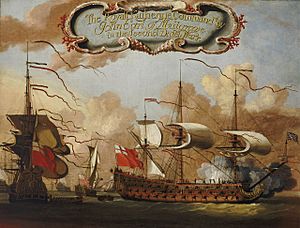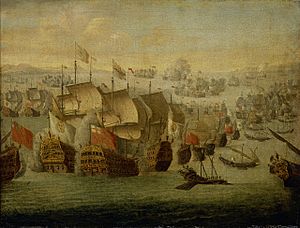HMS Royal Katherine (1664) facts for kids

HMS Royal Katherine, illustrated from a painting in 1664.
|
|
Quick facts for kids History |
|
|---|---|
| Name | HMS Royal Katherine |
| Ordered | October 1661 |
| Builder | Christopher Pett, Woolwich Dockyard |
| Laid down | May 1662 |
| Launched | 26 October 1664 |
| Commissioned | 13 March 1665 |
| Renamed | HMS Ramillies, 1706 |
| Fate | Wrecked, 15 February 1760 |
| Notes | |
| General characteristics | |
| Class and type | 84-gun second rate ship of the line |
| Tons burthen | 1037 75⁄94 bm |
| Length | 121 ft (37 m) (keel) |
| Beam | 40 ft (12 m) |
| Draught | 20 ft 0 in (6.10 m) |
| Depth of hold | 17 ft 2 in (5.23 m) |
| Propulsion | Sails |
| Sail plan | Full-rigged ship |
| Armament | 84 guns of various weights of shot (86 guns by 1685) |
| Notes | Rebuilt in 1702 |
| General characteristics after 1702 rebuild | |
| Class and type | 90-gun second rate ship of the line |
| Tons burthen | 1395 tons bm |
| Length | 160 ft (49 m) (gundeck) |
| Beam | 44 ft 6 in (13.56 m) |
| Depth of hold | 18 ft 6 in (5.64 m) |
| Propulsion | Sails |
| Sail plan | Full-rigged ship |
| Armament | 90 guns of various weights of shot |
| Notes | Rebuilt, 1749 |
| General characteristics after 1749 rebuild | |
| Class and type | 1741 proposals 90-gun second rate ship of the line |
| Tons burthen | 1689 tons bm |
| Length | 168 ft (51 m) (gundeck) |
| Beam | 48 ft (15 m) |
| Depth of hold | 20 ft 2 in (6.15 m) |
| Propulsion | Sails |
| Sail plan | Full-rigged ship |
| Armament |
|
HMS Royal Katherine was a large warship of the Royal Navy. It was built in 1664 and had 84 guns. Later, it was renamed HMS Ramillies in 1706.
This ship was a "second-rate ship of the line." This means it was a very powerful warship, designed to fight in a line formation during battles at sea. It was also a "full-rigged" ship, meaning it had three masts with square sails.
Royal Katherine fought in many important battles. These included the Second and Third Anglo-Dutch Wars against the Dutch. It also fought in the War of the Grand Alliance. The ship was rebuilt several times to make it stronger and carry more guns.
In 1706, it was renamed Ramillies to celebrate a big victory by John Churchill. Sadly, Ramillies was wrecked in a storm in 1760.
Contents
Launching a Mighty Ship
Royal Katherine was launched in 1664 at Woolwich Dockyard. This was a very special event! King Charles II himself was there to launch the ship.
A famous naval official named Samuel Pepys also attended. He wrote about the launch in his diary. Years later, this event was even turned into a radio show by BBC Radio 4.
Battles at Sea
Royal Katherine saw a lot of action in its early years. It fought in two major conflicts against the Dutch, known as the Anglo-Dutch Wars.
Fighting the Dutch
In the Second Anglo-Dutch War, Royal Katherine took part in several big battles:
- The Battle of Lowestoft in June 1665.
- The Four Days' Battle in June 1666, which was a very long and fierce fight.
- The St. James's Day Battle in August 1666.
In June 1667, during the Raid on the Medway, the ship was purposely sunk. This was done to stop the Dutch from capturing it. Luckily, it was later brought back up and repaired.
More Wars and Battles
Royal Katherine returned to battle during the Third Anglo-Dutch War (1672–1674). In the Battle of Solebay in June 1672, the Dutch briefly captured the ship. But it was quickly taken back by the English on the same day!
The ship also fought in the Battle of Schooneveld. Later, it saw action in the War of the Grand Alliance. This included the important Battle of Barfleur in May 1692.
Rebuilding and Renaming
Warships like Royal Katherine were often rebuilt. This helped to keep them strong and up-to-date with new designs.
First Rebuild and New Name
In 1702, Royal Katherine was rebuilt at Portsmouth. After this, it became an even more powerful ship, now carrying 90 guns. It served as the main ship (flagship) for Admiral George Rooke in the War of the Spanish Succession.

In 1706, the ship was given a new name: Ramillies. This was to honor John Churchill's great victory at the Battle of Ramillies that same year.
Second Rebuild
Ramillies was rebuilt again at Portsmouth Dockyard between 1742 and 1743. It remained a 90-gun ship.
The ship then served in the Seven Years' War. It was the flagship for Admiral John Byng. During this time, Admiral Byng failed to help Port Mahon, which led to the loss of the island of Minorca to the French. Admiral Byng was later controversially punished for this.
The Final Voyage
On February 15, 1760, Ramillies was tragically wrecked. The ship was sailing near Hope Cove in Devon, England. The ship's master made a mistake about their exact location.
A strong wind was blowing the ship towards the shore. The captain ordered the anchors to be dropped, hoping to stop the ship. But the seabed was sandy, so the anchors couldn't hold. Ramillies kept drifting closer to the cliffs.
After several hours, the ship hit the cliffs below Bolt Tail and sank. Out of a crew of 850 men, only 27 survived. The sad story of the sinking became a popular folk song called "The Loss of the Ramillies."

